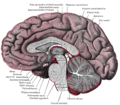Pons
| Pons | |
|---|---|
Brain stem | |
| Artery | pontine arteries |
| Vein | transverse and lateral pontine veins |
| Identifiers | |
| MeSH | D011149 |
| NeuroNames | 547 |
| NeuroLex ID | birnlex_733 |
| TA98 | A14.1.03.010 |
| TA2 | 5921 |
| FMA | 67943 |
| Anatomical terms of neuroanatomy] | |
The pons (pl.: pontes; from Latin pons, "bridge") is part of the brainstem that in humans and other mammals, lies inferior to the midbrain, superior to the medulla oblongata and anterior to the cerebellum.
The pons is also called the pons Varolii ("bridge of Varolius"), after the Italian anatomist and surgeon
Structure
The pons in humans measures about 2.5 centimetres (0.98 in) in length.[2] It is the part of the brainstem situated between the midbrain and the medulla oblongata,[3] and in front of the cerebellum.[citation needed] The horizontal medullopontine sulcus demarcates the boundary between the pons and medulla oblongata on the ventral aspect of the brainstem, and the roots of cranial nerves VI/VII/VIII emerge from the brainstem along this groove.[4] The junction of pons, medulla oblongata, and cerebellum forms an angle - the cerebellopontine angle.[5] The superior pontine sulcus separates the pons from the midbrain.[6] Posteriorly, the pons curves on either side into a middle cerebellar peduncle.[3]
The pons can be broadly divided into two parts: the
The ventral aspect of the pons faces the clivus, with the pontine cistern intervening between the two structures. The ventral surface of the pons features a midline basilar sulcus along which the basilar artery may or may not course. There is a bulge to either side of the basilar sulcus, created by the pontine nuclei that are interweaved amid the descending fibres within the substance of the pons. The superior cerebellar artery winds around the upper margin of the pons.[3]
Vasculature
Most of the pons is supplied by the
Development
During
Nuclei

A number of
- mid-pons: the principal sensory nucleus of the trigeminal nerve (V)
- mid-pons: the motor nucleus for the trigeminal nerve(V)
- lower down in the pons: abducens nucleus (VI)
- lower down in the pons: facial nerve nucleus(VII)
- lower down in the pons: cochlear nuclei) (VIII)
Function
Functions of these four cranial nerves (V-VIII) include regulation of respiration, control of involuntary actions, sensory roles in hearing, equilibrium, and taste, and in facial sensations such as touch and pain, as well as motor roles in eye movement, facial expressions, chewing, swallowing, and the secretion of saliva and tears.[2]
The pons contains nuclei that relay signals from the forebrain to the cerebellum, along with nuclei that deal primarily with sleep, respiration, swallowing, bladder control, hearing, equilibrium, taste, eye movement, facial expressions, facial sensation, and posture.[2]
Within the pons is the
The pons is implicated in sleep paralysis, and may also play a role in generating dreams.[9]
Clinical significance
- Central pontine myelinolysis is a demyelinating disease that causes difficulty with sense of balance, walking, sense of touch, swallowing and speaking. In a clinical setting, it is often associated with transplant or rapid correction of blood sodium. Undiagnosed, it can lead to death or locked-in syndrome.
Other animals
Evolution
The pons first evolved as an offshoot of the medullary
Additional images
-
Location and topography of pons (animation)
-
Axial section of the pons, at its upper part
-
Hind- and mid-brains; posterolateral view
-
Median sagittal section of brain
-
Nuclei of the pons and brainstem
-
Cerebrum. Deep dissection. Inferior dissection.
References
- ^ Gray, Henry (1862). Anatomy, descriptive and surgical. Blanchard and Lea. pp. 514–. Retrieved 10 November 2010.
- ^ a b c d e f Saladin, Kenneth S. (2007). Anatomy & physiology the unity of form and function. Dubuque, Iowa: McGraw-Hill.
- ^ ISBN 978-0-7295-3752-0.
- ^ "sulcus bulbopontis". TheFreeDictionary.com. Retrieved 8 June 2023.
- ^ "cerebellopontile angle". TheFreeDictionary.com. Retrieved 8 June 2023.
- ISBN 0683014552.
- ^ "pars basilaris pontis". TheFreeDictionary.com. Retrieved 8 June 2023.
- ^ "tegmentum pontis". TheFreeDictionary.com. Retrieved 8 June 2023.
- ^ Koch, Christof. "Dream States: A Peek into Consciousness". Scientific American. Scientific American. Retrieved 17 September 2020.
- ^ Pritchard and Alloway Medical Neuroscience
- ^ Butler and Hodos Comparative vertebrate neuroanatomy: evolution and adaptation
- Pritchard, TE & Alloway, D (1999). Medical neuroscience. Hayes Barton Press. ISBN 978-1-59377-200-0.
- Butler, AB & Hodos, W (2005). Comparative vertebrate neuroanatomy: evolution and adaptation. Wiley-Blackwell. ISBN 978-0-471-21005-4.






